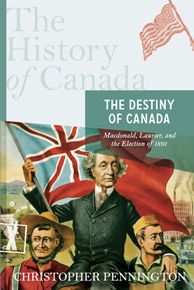|
The story of this great
contest—which turned on the issue of continental free trade but could just as
easily have torn the country apart along linguistic and religious lines—is
engagingly recounted by Christopher Pennington in The Destiny of Canada:
Macdonald, Laurier, and the Election of 1891, published by Penguin as a part
of its History of Canada Series. The young historian makes a good case in his
Preface for why this largely neglected election is actually a pivotal episode in
Canadian history that richly deserves a proper book-length treatment. In the 300
pages that follow, Pennington does a splendid job of providing one.
|
Macdonald the Conservative |
 By 1891, Macdonald’s National Policy—a system of high tariffs on British and
American imports—had been in effect for twelve years. Its ostensible purpose was
to protect Canadian manufacturers from foreign competition in order to allow
them to grow. It went hand in hand with the building of the Canadian Pacific
Railway all the way out to British Columbia in an effort to industrialize and
unite the country and to assert its independence from the United States.
By 1891, Macdonald’s National Policy—a system of high tariffs on British and
American imports—had been in effect for twelve years. Its ostensible purpose was
to protect Canadian manufacturers from foreign competition in order to allow
them to grow. It went hand in hand with the building of the Canadian Pacific
Railway all the way out to British Columbia in an effort to industrialize and
unite the country and to assert its independence from the United States.
But the National Policy
had not succeeded in lifting Canada out of its “economic doldrums.”
Manufacturers supported it, to be sure, as they were its direct beneficiaries. A
million Canadians, though, had moved to the US to find work since the early
1860s, at a time when the total population of Canada was under five million. No
wonder, then, that “many Canadians had lost faith in the wisdom of fighting a
never-ending tariff war with their vastly larger and more prosperous southern
neighbour.”
Farmers, especially,
disliked the protectionist measure, and longed for a return to “the blissful
days of the Reciprocity Treaty of 1854, when natural products had crossed the
border freely.” They wanted better access to the American market for their
produce, and they also resented paying higher prices for Canadian manufactures
than they would have paid if they could have freely imported cheaper American
products. And in an age when three-quarters of the population still worked the
land, what farmers wanted could not easily be ignored.
Enter Wilfrid Laurier,
who assumed the leadership of the Liberal Party from Edward Blake after the
Liberals lost the 1887 election. Other prominent Liberals, notably Sir Richard
Cartwright, were known to be ardent free traders, but Blake had not pushed for
free trade when he led the party, and neither did Laurier at first. Just weeks
after assuming the leadership of the party, though, Laurier was informed by
Cartwright that Ontario farmers were taking it upon themselves to push the free
trade agenda. Liberal newspapers like the Toronto Globe, which usually
marched to a beat set by top Liberal politicians, “jumped on the bandwagon
without getting permission from the federal party leaders.” The Toronto Mail,
formerly a Conservative mouthpiece but now the country’s largest independent
paper, also got behind the movement.
Despite the pressure to
declare a position, Laurier took his time making up his mind. Pennington tells
us that he had “never cared very much about economics,” although he did have “a
natural sympathy for free trade, and felt that some kind of deal with the United
States would be good for Canada.” It took over half a year, but finally, Laurier
and the Liberal Party declared for something they called “unrestricted
reciprocity,” which meant “complete free trade with the United States, but with
the retention of customs houses along the border and the continuing right of
each country to set its own tariffs against other countries.”
|

